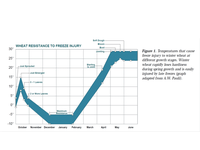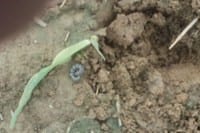Good afternoon,
The weather is cooperating and corn and soybeans are being planted throughout the county. There was a slowdown earlier this week with some rain, but now activity is back to its previous level. I’ve been looking around for some emerged corn, but have yet to be able to row any fields. There is also evidence of manure application with the warmer temperatures. I know when I used to hear people talk about the odors when I hauled manure, I used to tell them that it ‘smelled like money’ to me. Whatever the case, conditions are favorable for field work and much is being accomplished. Read the attached article that I wrote this week about planting progress.
If you are looking for plants for your landscape or garden, the Master Gardener Volunteers will be having their 12th Annual Plant Sale in the Arts & Crafts Building at the fairgrounds tomorrow (5/9). It will start with coffee and browsing at 8:30 am and then sales from 9:00-12:00 noon. There should be a wide variety of plants for your selection, as well as lots of good free gardening advice from the many garden clubs and societies from around the county that will have booths at this sale. See the attached flyer for more information.
The final Spring Garden Library Program conducted by the Master Gardeners will be held this coming Wednesday (5/13) at the Mary Lou Johnson District Library in Kenton. Master Gardener Volunteers Richard Aller and Sandy Pruden will present a program on annuals and perennials: selection, care, planting, and what’s new in the variety of plants available. See the attached flyer for more details of this program which will start at 7:00 pm.
I received a call from someone looking for horse hay for sale, preferably small bales containing orchard grass and timothy. Often times I receive requests for hay and straw, so if you have some for sale or know of anyone who has some available, please let me know so that I can put together a list with contacts that I could make it available to anyone who asks. If you are out riding a horse in this warm weather or just working outside, you will want to beware of the potential for ticks. Hancock County Extension Educator Ed Lentz wrote an informative article about this pest that I have attached to this email.
You may have heard about the Avian Influenza outbreak in other states. Fortunately, this disease has not made its way to Ohio. If it did, it has the potential to be devastating to the poultry industry. If you have poultry, even if it is a 4-H/FFA project or backyard flock, you should read the article from OSU found at http://cfaes.osu.edu/news/articles/ohio-poultry-owners-advised-increase-biosecurity-virus-spreads-in-western-us for more information. No poultry on your farm? Then you might want to think about the effect on the demand for corn and soybean meal. You can figure about 1 bushel of corn eaten per layer per year, 10 pounds of corn per broiler and 2/3 of a bushel of corn per turkey (10-12 weeks). If we would lose ½ of our poultry for a 6 month period of time you would reduce corn demand by 27,000,000 million bushels, the equivalent of 9% of our state corn production.
Below are some more agronomy related articles that you might be interested in reading. Remember to keep a safe working environment as you continue to plant this season’s crops.
Mark
Cold Weather and Wheat Injury – Laura Lindsey, Pierce Paul
Last week, temperatures in northern Ohio dipped below freezing prompting some concerns about possible injury to the wheat crop. The effect of cold weather depends on the wheat growth stage. Maximum resistance to cold weather occurs in December-February. As wheat greens-up, the plant becomes less tolerant of freezing temperatures (see wheat freeze chart), which could be particularly damaging after jointing when the growing point is above the soil surface. Go to http://corn.osu.edu/newsletters/2015/2015-10/cold-weather-and-wheat-injury to continue reading this article.
Black Cutworms and Armyworms Still a Concern – Andy Michel
Reports of black cutworm and armyworms catches are still coming in from surrounding states. The big concern over the next few weeks will be egg hatch and larval growth. Both hatch and growth is difficult to predict and is largely based on temperature and growing degree days. From the temperature outlook, we should see 3rd or 4th instars of black cutworm by the 2nd or 3rd week of May, weather dependent. Corn from the V2 to the V6 stage is vulnerable to damage and cutting, and, if much of the planting starts at the end of this week or the beginning of next, we may see some fields with heavy feeding. Go to http://corn.osu.edu/newsletters/2015/2015-10/black-cutworms-and-armyworms-still-a-concern to finish reading this article.
Nitrogen Value of Spring Applied Manure – Glen Arnold
Many Ohio livestock farmers were unable to apply their normal amounts of manure last fall due to wet weather and a delayed harvest season. As a result, many producers need to haul manure this spring before the planting season. The ammonium nitrogen and a portion of the organic nitrogen contained in spring applied manure are generally available for the growing crop. According to OSU Extension bulletin 604, 50 to 75 percent of the ammonia portion of the nitrogen could be captured if the manure is injected during application or incorporated within one day if surface applied. Approximately one-third of the organic portion of the manure nitrogen will be available regardless of whether the manure is incorporated or not. Go to http://corn.osu.edu/newsletters/2015/2015-10/nitrogen-value-of-spring-applied-manure to continue reading about manure research.
Adjusting Corn Management Practices for a Late Start – Peter Thomison, Steve Culman, Mark Loux
As prospects for a timely start to spring planting diminish, growers need to reassess their planting strategies and consider adjustments. Since delayed planting reduces the yield potential of corn, the foremost attention should be given to management practices that will expedite crop establishment. The following are some suggestions and guidelines to consider in dealing with a late planting season. Although the penalty for late planting is important, care should be taken to avoid tillage and planting operations when soil is wet. Yields may be reduced somewhat this year due to delayed planting, but effects of soil compaction can reduce yield for several years to come. Go to http://corn.osu.edu/newsletters/2015/2015-10/adjusting-corn-management-practices-for-a-late-start to read more about corn management practices.
We have Nematodes in our Corn Fields – Pierce Paul, Terry Niblack, Abasola Simon
A total 425 corn fields were surveyed for plant-parasitic nematodes during the 2013 and 2014 growing seasons. In each year, soil samples were collected from 15-16 fields in each of 28 counties, across 6 soil regions, and nematodes were identified and counted. Ten major morphological types were found, with populations ranging from 0 to 1,164 nematodes per 100 cm3 of soil. Spiral, lesion, lance, dagger, stunt, pin, ring, stubby-root, cyst, and tylenchid nematodes were each found in at least one field. Go to http://corn.osu.edu/newsletters/2015/2015-9/we-have-nematodes-in-our-corn-fields to learn more about nematodes.
Mark A. Badertscher
Agriculture and Natural Resources Educator
OSU Extension Hardin County
1021 W. Lima Street, Suite 103, Kenton, OH 43326
419-674-2297 Office





